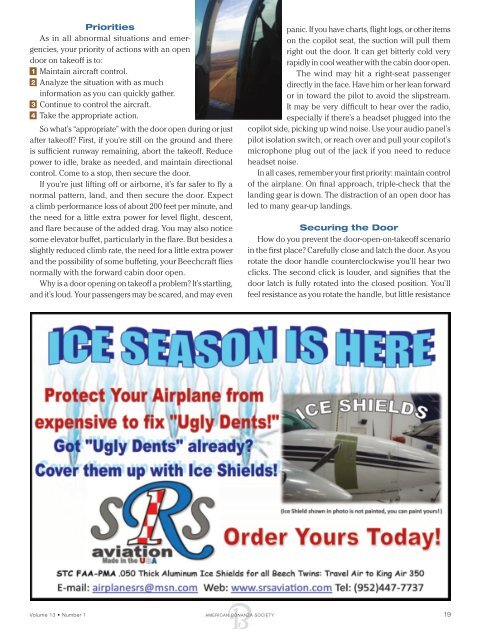Insurance Discount May Pay for Your BPPP Training - American ...
Insurance Discount May Pay for Your BPPP Training - American ...
Insurance Discount May Pay for Your BPPP Training - American ...
Create successful ePaper yourself
Turn your PDF publications into a flip-book with our unique Google optimized e-Paper software.
Priorities<br />
As in all abnormal situations and emergencies,<br />
your priority of actions with an open<br />
door on takeoff is to:<br />
1 Maintain aircraft control.<br />
n<br />
2 Analyze the situation with as much<br />
in<strong>for</strong>mation as you can quickly gather.<br />
3 Continue to control the aircraft.<br />
n<br />
4 Take the appropriate action.<br />
So what’s “appropriate” with the door open during or just<br />
after takeoff? First, if you’re still on the ground and there<br />
is sufficient runway remaining, abort the takeoff. Reduce<br />
power to idle, brake as needed, and maintain directional<br />
control. Come to a stop, then secure the door.<br />
If you’re just lifting off or airborne, it’s far safer to fly a<br />
normal pattern, land, and then secure the door. Expect<br />
a climb per<strong>for</strong>mance loss of about 200 feet per minute, and<br />
the need <strong>for</strong> a little extra power <strong>for</strong> level flight, descent,<br />
and flare because of the added drag. You may also notice<br />
some elevator buffet, particularly in the flare. But besides a<br />
slightly reduced climb rate, the need <strong>for</strong> a little extra power<br />
and the possibility of some buffeting, your Beechcraft flies<br />
normally with the <strong>for</strong>ward cabin door open.<br />
Why is a door opening on takeoff a problem? It’s startling,<br />
and it’s loud. <strong>Your</strong> passengers may be scared, and may even<br />
panic. If you have charts, flight logs, or other items<br />
on the copilot seat, the suction will pull them<br />
right out the door. It can get bitterly cold very<br />
rapidly in cool weather with the cabin door open.<br />
The wind may hit a right-seat passenger<br />
directly in the face. Have him or her lean <strong>for</strong>ward<br />
or in toward the pilot to avoid the slipstream.<br />
It may be very difficult to hear over the radio,<br />
especially if there’s a headset plugged into the<br />
copilot side, picking up wind noise. Use your audio panel’s<br />
pilot isolation switch, or reach over and pull your copilot’s<br />
microphone plug out of the jack if you need to reduce<br />
headset noise.<br />
In all cases, remember your first priority: maintain control<br />
of the airplane. On final approach, triple-check that the<br />
landing gear is down. The distraction of an open door has<br />
led to many gear-up landings.<br />
Securing the Door<br />
How do you prevent the door-open-on-takeoff scenario<br />
in the first place? Carefully close and latch the door. As you<br />
rotate the door handle counterclockwise you’ll hear two<br />
clicks. The second click is louder, and signifies that the<br />
door latch is fully rotated into the closed position. You’ll<br />
feel resistance as you rotate the handle, but little resistance<br />
Volume 13 • Number 1 AMERICAN BONANZA SOCIETY 19

















